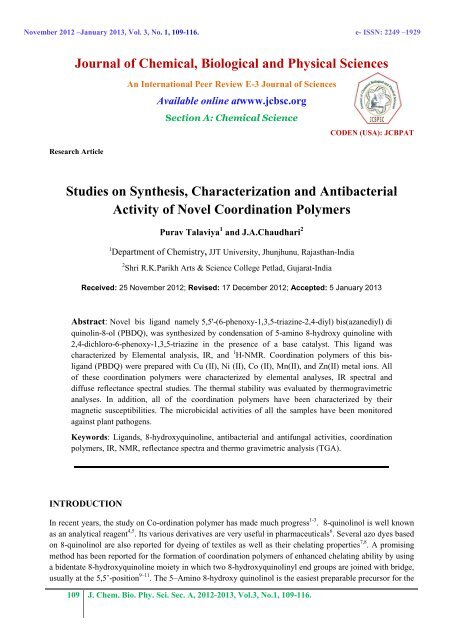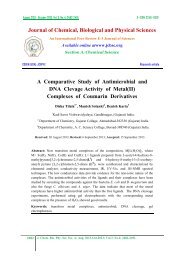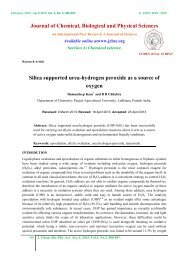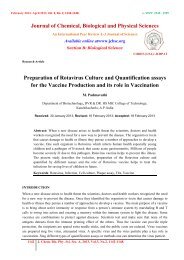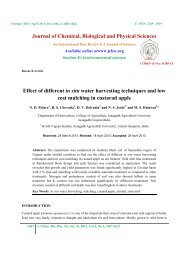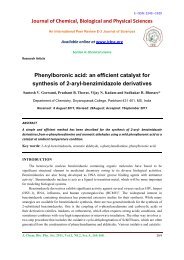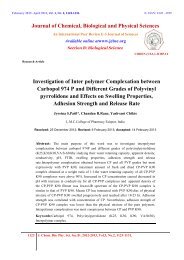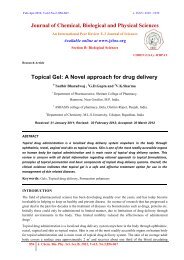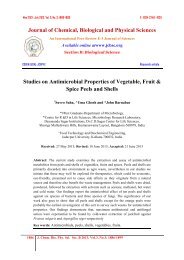Studies on Synthesis, Characterization and Antibacterial Activity of ...
Studies on Synthesis, Characterization and Antibacterial Activity of ...
Studies on Synthesis, Characterization and Antibacterial Activity of ...
- No tags were found...
You also want an ePaper? Increase the reach of your titles
YUMPU automatically turns print PDFs into web optimized ePapers that Google loves.
November 2012 –January 2013, Vol. 3, No. 1, 109-116. e- ISSN: 2249 –1929Journal <strong>of</strong> Chemical, Biological <strong>and</strong> Physical SciencesAn Internati<strong>on</strong>al Peer Review E-3 Journal <strong>of</strong> SciencesAvailable <strong>on</strong>line atwww.jcbsc.orgSecti<strong>on</strong> A: Chemical ScienceCODEN (USA): JCBPATResearch Article<str<strong>on</strong>g>Studies</str<strong>on</strong>g> <strong>on</strong> <strong>Synthesis</strong>, Characterizati<strong>on</strong> <strong>and</strong> <strong>Antibacterial</strong><strong>Activity</strong> <strong>of</strong> Novel Coordinati<strong>on</strong> PolymersPurav Talaviya 1 <strong>and</strong> J.A.Chaudhari 21 Department <strong>of</strong> Chemistry, JJT University, Jhunjhunu, Rajasthan-India2 Shri R.K.Parikh Arts & Science College Petlad, Gujarat-IndiaReceived: 25 November 2012; Revised: 17 December 2012; Accepted: 5 January 2013Abstract: Novel bis lig<strong>and</strong> namely 5,5'-(6-phenoxy-1,3,5-triazine-2,4-diyl) bis(azanediyl) diquinolin-8-ol (PBDQ), was synthesized by c<strong>on</strong>densati<strong>on</strong> <strong>of</strong> 5-amino 8-hydroxy quinoline with2,4-dichloro-6-phenoxy-1,3,5-triazine in the presence <strong>of</strong> a base catalyst. This lig<strong>and</strong> wascharacterized by Elemental analysis, IR, <strong>and</strong> 1 H-NMR. Coordinati<strong>on</strong> polymers <strong>of</strong> this bislig<strong>and</strong>(PBDQ) were prepared with Cu (II), Ni (II), Co (II), Mn(II), <strong>and</strong> Zn(II) metal i<strong>on</strong>s. All<strong>of</strong> these coordinati<strong>on</strong> polymers were characterized by elemental analyses, IR spectral <strong>and</strong>diffuse reflectance spectral studies. The thermal stability was evaluated by thermogravimetricanalyses. In additi<strong>on</strong>, all <strong>of</strong> the coordinati<strong>on</strong> polymers have been characterized by theirmagnetic susceptibilities. The microbicidal activities <strong>of</strong> all the samples have been m<strong>on</strong>itoredagainst plant pathogens.Keywords: Lig<strong>and</strong>s, 8-hydroxyquinoline, antibacterial <strong>and</strong> antifungal activities, coordinati<strong>on</strong>polymers, IR, NMR, reflectance spectra <strong>and</strong> thermo gravimetric analysis (TGA).INTRODUCTIONIn recent years, the study <strong>on</strong> Co-ordinati<strong>on</strong> polymer has made much progress 1-3 . 8-quinolinol is well knownas an analytical reagent 4,5 . Its various derivatives are very useful in pharmaceuticals 6 . Several azo dyes based<strong>on</strong> 8-quinolinol are also reported for dyeing <strong>of</strong> textiles as well as their chelating properties 7,8 . A promisingmethod has been reported for the formati<strong>on</strong> <strong>of</strong> coordinati<strong>on</strong> polymers <strong>of</strong> enhanced chelating ability by usinga bidentate 8-hydroxyquinoline moiety in which two 8-hydroxyquinolinyl end groups are joined with bridge,usually at the 5,5’-positi<strong>on</strong> 9–11 . The 5–Amino 8-hydroxy quinolinol is the easiest preparable precursor for the109 J. Chem. Bio. Phy. Sci. Sec. A, 2012-2013, Vol.3, No.1, 109-116.
<str<strong>on</strong>g>Studies</str<strong>on</strong>g>...Purav Talaviya et al.preparati<strong>on</strong> <strong>of</strong> bis-lig<strong>and</strong> <strong>and</strong> thus bis-lig<strong>and</strong>s based <strong>on</strong> 5–Amino 8–hydroxyquinoline have been reported forcoordinati<strong>on</strong> polymers 11, 12 . I<strong>on</strong> exchange resins have also been prepared from 5–amino 8–hydroxyquinoline<strong>and</strong> amino or hydroxyl functi<strong>on</strong>alized polymers 13,14 . The literature survey reveals that bis-8-hydroxyquinoline lig<strong>and</strong> having 1, 3, 5-triazine ring as a bridge has not been reported so far. Hence, it wasthought to undertake such type <strong>of</strong> study. Thus the present paper deals with synthesis, characterizati<strong>on</strong> <strong>and</strong>chelating properties <strong>of</strong> lig<strong>and</strong> (PBDQ) <strong>and</strong> its co-ordinati<strong>on</strong> polymers are shown in Scheme 1.110 J. Chem. Bio. Phy. Sci. Sec. A, 2012-2013, Vol.3, No.1, 109-116.
<str<strong>on</strong>g>Studies</str<strong>on</strong>g>...Purav Talaviya et al.Table-1: Analysis <strong>of</strong> PBDQ lig<strong>and</strong> <strong>and</strong> its metal chelatesEmpirical Formula Mol. Cal Yield Elemental Analysis (%) Found(Calcd)g/mol % C H N MC 27 H 19 N 7 O 3 489 68 66.25 (66.21) 3.91(3.87) 20.03(19.99) ---C 27 H 17 N 7 O 3 Cu .2H 2 O 586 70 55.24(55.19) 3.61(3.56) 16.70(16.65) 10.82(10.78)C 27 H 17 N 7 O 3 Ni .2H 2 O 582 67 55.6 8(55.64) 3.63(3.58) 16.83(16.79) 10.12(10.07)C 27 H 17 N 7 O 3 Co .2H 2 O 581 67 55.70(55.65) 3.64(3.59) 16.84(15.80) 10.08(10.04)C 27 H 17 N 7 O 3 Mn .2H 2 O 578 66 56.06(56.12) 3.66(3.62) 16.95(16.91) 09.50(09.45)C 27 H 17 N 7 O 3 Zn .2H 2 O 587 68 55.07(55.02) 3.59(3.55) 16.65(16.61) 11.11(11.06Table-2: Spectral features <strong>and</strong> magnetic moment <strong>of</strong> metal chelatesMetalChelatesµ effBMElectr<strong>on</strong>ic Transiti<strong>on</strong>s IR spectral feacturesData cm -1SpectralComm<strong>on</strong> for all cm -1PBDQ -Cu +2PBDQ -Ni +2 1.933.84226901586522988146958100C.TEg → 2 T 2 gA 2 g→ 3 T 1 g(P)A 2 g→ 3 T 1 g(F)A 2 g→ 3 T 2 g3300 Quinoline Moiety2200160015001090 C-O-M &PBDQ -Co +2 4.53 2072019880119904 T 1 g(F)→ 4 A 2 gT 1 g(F)→ 4 T 1 g(P)T 1 g(F)→ 4 T 2 g1420 O-M750 N-M660PBDQ -Mn +2 5.11 2296517655153796 A 1 g→ 6 A 1 g ( 4 Eg)A 1 g→ 4 T 2 g( 4 G)A 1 g→ 4 T 1 g( 4 G)PBDQ -Zn +2 Diamagnetic -----IR Analysis: The important infrared spectral b<strong>and</strong>s <strong>and</strong> their tentative assignments for the synthesizedlig<strong>and</strong> H 2 L <strong>and</strong> its coordinati<strong>on</strong> polymers were recorded as KBr disks <strong>and</strong> are shown in Table-2.IR spectrum <strong>of</strong> lig<strong>and</strong> <strong>of</strong> PBDQ show a broad b<strong>and</strong> extended from 3300 to 2200 cm -1 that might beresp<strong>on</strong>sible to phenolic -OH group b<strong>on</strong>ded to N atom <strong>of</strong> 8-hydroxyquinoline moieties 20 .Several b<strong>and</strong>s appeared between 1500 <strong>and</strong> 1600 cm -1 regi<strong>on</strong> may arised from aromatic breathing <strong>and</strong> 3400cm -1 for –NH group. The IR b<strong>and</strong> at 1580 cm -1 (C=N <strong>of</strong> 8-quinolinol system) <strong>of</strong> PBDQ lig<strong>and</strong> shifted tohigher frequency side 1600 cm -1 in the spectra <strong>of</strong> the metal complexes indicating involvement <strong>of</strong> nitrogen in112 J. Chem. Bio. Phy. Sci. Sec. A, 2012-2013, Vol.3, No.1, 109-116.
<str<strong>on</strong>g>Studies</str<strong>on</strong>g>...Purav Talaviya et al.the complexes formati<strong>on</strong> 21 , whereas the b<strong>and</strong> at 1420 cm -1 in the IR spectrum <strong>of</strong> PBDQ assigned to in-plane–OH deformati<strong>on</strong> was shifted towards higher frequency in the spectra <strong>of</strong> the coordinati<strong>on</strong> polymer due to theformati<strong>on</strong> <strong>of</strong> the M–O b<strong>on</strong>d 22 . This was further c<strong>on</strong>firmed by a weak b<strong>and</strong> at 1090 cm -1 corresp<strong>on</strong>ding to C–O–M stretching, while b<strong>and</strong>s around 750 <strong>and</strong> 660 cm -1 corresp<strong>on</strong>d to the N →M vibrati<strong>on</strong> 2 3.1 H NMR Analysis: The structural analysis <strong>of</strong> the lig<strong>and</strong> (PBDQ) was determined by 1 H NMR spectrum.NMR(DMSO) 6.9 – 8.2 ppm (15H) Multiplet Aromatic5.3 ppm (1H) Singlet (OH)4.0 ppm (1H) Singlet (NH)Magnetic Measurements: Magnetic moments <strong>of</strong> coordinati<strong>on</strong> polymers are given in Table-2. The diffuseelectr<strong>on</strong>ic spectrum <strong>of</strong> Cu +2 complex shows two broad b<strong>and</strong>s, 15865 <strong>and</strong> 22690 cm -1 . The first b<strong>and</strong> may bedue to a 2 Eg → 2 T 2 g transiti<strong>on</strong>, while the sec<strong>on</strong>d b<strong>and</strong> may be due to charge transfer. The first b<strong>and</strong> showsstructures suggesting a distorted octahedral structure for the Cu +2 metal complex 24,25 . The Co +2 metalcomplex gives rise to two absorpti<strong>on</strong> b<strong>and</strong>s at 20720 cm -1 , 19880 cm -1 <strong>and</strong> 11990 cm -1 which can beassigned 4 T 1 g(F)→ 4 A 2 g, 4 T 1 g(F)→ 4 T 1 g(P) <strong>and</strong> 4 T 1 g(F)→ 4 T 2 g transiti<strong>on</strong>s, respectively. These absorpti<strong>on</strong>b<strong>and</strong>s <strong>and</strong> the µ eff value indicate octahedral c<strong>on</strong>figurati<strong>on</strong> <strong>of</strong> the Co +2 metal complex 26,27 . The spectrum <strong>of</strong>Mn +2 polymeric complex comprised three b<strong>and</strong>s at 22965 cm -1 ,17655 cm -1 <strong>and</strong> 15379 cm -1 . These b<strong>and</strong>smay be assigned to 6 A 1 g→ 6 A 1 g( 4 Eg), 6 A 1 g→ 4 T 2 g( 4 G) <strong>and</strong> 6 A 1 g→ 4 T 1 g( 4 G) transiti<strong>on</strong>s, respectively. The highintensity <strong>of</strong> the b<strong>and</strong>s also suggests that they may have some charge transfer character. The magneticmoment is found to be lower than normal range. In the absence <strong>of</strong> low temperature measurement <strong>of</strong>magnetic moment, it is difficult to attach any significance to this. As the spectrum <strong>of</strong> the metal complex <strong>of</strong>Ni +2 show three distinct b<strong>and</strong>s at 22988 cm -1 ,14695 cm -1 <strong>and</strong> 8100 cm -1 are assigned as 3 A 2 g→ 3 T 1 g(P),3 A 2 g→ 3 T 1 g(F) <strong>and</strong> 3 A 2 g→ 3 T 2 g transiti<strong>on</strong>, respectively, suggesting the octahedral envir<strong>on</strong>ment for Ni +2 i<strong>on</strong>.The observed µ eff values in the range 1.93–5.11 B.M are c<strong>on</strong>sistent with the above moiety 28,29 .Thermal <str<strong>on</strong>g>Studies</str<strong>on</strong>g>: The TGA data for the Co-ordinati<strong>on</strong> polymers samples at different temperatures indicatethat the degradati<strong>on</strong> <strong>of</strong> the co-ordinati<strong>on</strong> polymers is noticeable bey<strong>on</strong>d 300 0 C. The rate <strong>of</strong> degradati<strong>on</strong>becomes a maximum at a temperature between 400 <strong>and</strong> 500 0 C. This may be due to accelerati<strong>on</strong> by metaloxides, which form in situ. Each polymer lost about 60% <strong>of</strong> its weight when heated up to 690 0 C. Inspecti<strong>on</strong><strong>of</strong> the thermograms <strong>of</strong> all coordinated polymer samples revealed that all samples suffered appreciableweight loss in the range <strong>of</strong> 150 to 280 0 C. This may be due to the presence <strong>of</strong> a coordinated water molecule.Antimicrobial Activities: The antibacterial <strong>and</strong> antifungal data obtained from analysis are shown inTable-3 <strong>and</strong> Table-4, respectively. The increase in antimicrobial activity may be c<strong>on</strong>sidered in light <strong>of</strong>Overt<strong>on</strong>e’s c<strong>on</strong>cept 30 <strong>and</strong> Tweedy’s chelati<strong>on</strong> theory 31 . According to Overt<strong>on</strong>e’s c<strong>on</strong>cept <strong>of</strong> cellpermeability, the lipid membrane that surrounds the cell favors the passage <strong>on</strong>ly <strong>of</strong> lipid-soluble materialsdue to which liposolubility is an important factor c<strong>on</strong>trolling the antimicrobial activity. On complexati<strong>on</strong>,the polarity <strong>of</strong> the metal i<strong>on</strong> will be reduced largely due to the overlap <strong>of</strong> the lig<strong>and</strong> orbital <strong>and</strong> partialsharing <strong>of</strong> the positive charge <strong>of</strong> the metal i<strong>on</strong> with d<strong>on</strong>or groups. Further, it increases the delocalizati<strong>on</strong> <strong>of</strong> -electr<strong>on</strong>s over the whole chelate ring <strong>and</strong> enhances the lipophilicity <strong>of</strong> the coordinati<strong>on</strong> polymers. Thisincreased lipophilicity enhances the penetrati<strong>on</strong> <strong>of</strong> the coordinati<strong>on</strong> polymer into lipid membranes <strong>and</strong>blocks the metal binding sites in the enzymes <strong>of</strong> microorganisms. These coordinati<strong>on</strong> polymers also disturbthe respirati<strong>on</strong> process <strong>of</strong> the cell <strong>and</strong> thus block the synthesis <strong>of</strong> proteins, which restricts further growth <strong>of</strong>the organisms.113 J. Chem. Bio. Phy. Sci. Sec. A, 2012-2013, Vol.3, No.1, 109-116.
<str<strong>on</strong>g>Studies</str<strong>on</strong>g>...Purav Talaviya et al.Table-3: <strong>Antibacterial</strong> activity <strong>of</strong> coordinati<strong>on</strong> PolymersCompounds Gram +ve Gram –veBacillus Staphylococcus klebsiella Salm<strong>on</strong>ella E.coliSubtilis Aureuspromioe TyphiPBDQ 20 19 22 22 23(Cu BDQ(H 2 O) 2 ) n 34 36 31 32 29(Co BDQ(H 2 O) 2 ) n 32 30 24 23 23(Ni PBDQ(H 2 O) 2 ) n 30 26 26 25 26(Mn PBDQ(H 2 O) 2 ) n 31 33 24 24 22(Zn PBDQ(H 2 O) 2 ) n 30 32 29 32 23Table-4: Antifungal activity <strong>of</strong> coordinati<strong>on</strong> PolymersCompounds Z<strong>on</strong>e <strong>of</strong> Inhibiti<strong>on</strong> at 1000 ppm (%)AspergillusNigerC<strong>and</strong>idaalbicansTrichodermaharsianumMucormucedoPBDQ 29 24 24 20 21(Cu PBDQ(H 2 O) 2 ) n 40 30 38 34 40(Co PBDQ(H 2 O) 2 ) n 32 29 30 28 30(Ni PBDQ(H 2 O) 2 ) n 31 26 32 25 26(Mn PBDQ(H 2 O) 2 ) n 31 26 32 25 32(Zn PBDQ(H 2 O) 2 ) n 35 26 30 24 28Botrytis cinereaCoordinati<strong>on</strong> polymers exhibit higher biocidal activity as compared with the free lig<strong>and</strong>s; from thecomparative analysis shown in Table-3 <strong>and</strong> Table-4, respectively, it is observed that all the coordinati<strong>on</strong>polymer are more potent biocidals than the free lig<strong>and</strong>s. From the data obtained, it is clear that Cu (II) ishighly active am<strong>on</strong>g the coordinati<strong>on</strong> polymer <strong>of</strong> the respective metal.CONCLUSIONThe results at present work show the following c<strong>on</strong>clusi<strong>on</strong>s. The design synthesis <strong>of</strong> new bis-lig<strong>and</strong> has beenperformed successfully, <strong>and</strong> analysed by normaly spectral study. A series <strong>of</strong> some novel coordinati<strong>on</strong>polymer from bis-lig<strong>and</strong>s with transiti<strong>on</strong> metals have been prepared <strong>and</strong> characterized for their spectral <strong>and</strong>magnetic properties. All the synthesized coordinati<strong>on</strong> polymer compounds were screened for theirantimicrobial activity. The coordinati<strong>on</strong> polymers exhibited behave toxic for gram-negative bacteria (E.coli,sam<strong>on</strong>ella typhi <strong>and</strong> klebsiella promioe) <strong>and</strong> gram-positive bacteria (Bacillus subtilis <strong>and</strong> staphylococcusaureus), <strong>and</strong> plant pathogenic organisms (fungi) used were Aspergillus niger, C<strong>and</strong>ida albicans,Trichoderma harsianum, Mucor mucedo, <strong>and</strong> Botrytis cinerea microorganisms. In comparis<strong>on</strong> with thelig<strong>and</strong>, coordinati<strong>on</strong> polymers were more active against <strong>on</strong>e or more bacterial strains, thus introducing anovel class <strong>of</strong> metal-based bactericidal agents. The informati<strong>on</strong> regarding geometry <strong>of</strong> the coordinati<strong>on</strong>polymer was obtained from their electr<strong>on</strong>ic <strong>and</strong> magnetic moment values. The magnetic moment values <strong>of</strong>coordinati<strong>on</strong> polymer indicate an octahedral geometry.114 J. Chem. Bio. Phy. Sci. Sec. A, 2012-2013, Vol.3, No.1, 109-116.
<str<strong>on</strong>g>Studies</str<strong>on</strong>g>...Purav Talaviya et al.ACKNOWLEDGEMENTWe are grateful to the Principal, Shri R.K.Parikh Arts <strong>and</strong> Science College Petlad for providing thenecessary research facilities.REFERENCES1. S.Sherman, J. Gan<strong>on</strong>, G. Buchi, K. O.Howell <strong>and</strong> W. R. Eneyel, (1980). Chem.Tech.(Vol. 9), Epoxy Resins, John Wiley Inc., New York, 267.2. H.S. Freeman <strong>and</strong> J. F. Esancy (1991). Colour Chemistry, Elsever, L<strong>on</strong>d<strong>on</strong> <strong>and</strong> NewYork.3. E. M Smolin <strong>and</strong> L.Rapopret, (1954). S-Triazine <strong>and</strong> Derivatives, Interscience, NewYork.4. A.I.Vogel, A Textbook <strong>of</strong> Quantitative Chemical Analysis, 5th ed.; revised by J.Besselt,R.C Denny, Jeffery, J.H.; Mendham, J. ELBS: L<strong>on</strong>d<strong>on</strong>, 1996.5. V.M. Ivanor; T.F Metkina,. Zh. Anal. Khim 1978, 33, 2426.6. J.H. Burckhalter, V.C.Stephars, H.C.Searberough, W.S.Briniger, W.E Edergt<strong>on</strong>, J. Am.Chem. Soc. 1954, 76, 4902.7. C.Vogel; Heinz, W. Brazil Pat., 78, 05,009, 1977; Ger.Pat. 2,832,758, 1977.8. J.H Burckhalter; R. Leib, Eswaran. J. Org. Chem. 1961, 26, 4078.9. H.Horowitz,; J.P. Perros, J. Inorg. Nucl. Chem. 1964, 26, 139.10. Bailer, Jr., C.J.; Judd, M.L.; McLean, M.J. Coordinati<strong>on</strong> Polymers (WADC TechnicalReports), 1959, 116, 58–51 lpar;Part II).11. R.D.Patel, S.R.Patel, H.S. Patel, Eur. Polym. J. 1987, 23, 229.12. T.B.Shah, H.S. Patel, R.B. Dixit, B.C. Dixit, Int. J. Polym. Anal. <strong>and</strong> Charact. 2003, 8,369.13. C.Xian Ren, F. Yuqi, I. Hisanori, H.Kazuhisa, O.Kousaburo, Analytical Sci. 1995, 11,313. Bis Bidentate Lig<strong>and</strong> 527 Downloaded By [INFLIBNET India Order] At: 03:55 18June 2011.14. W.Abraham, D. Abraham, R. Guy, <strong>and</strong> Abraham, P. Reactive Polymers, I<strong>on</strong> Exchangers,Sorbents. 1984, 2, 301.15. K.D. Patel, S.C.Pachani, R.B. Dixit, Int. J. Inorganic <strong>and</strong> Orgeno Metallic Polymers2003.16. H.S. Patel, V.K. Patel, Indian J. Hetrocycl Chem. 2003, 12, 253.17. A.I. Vogel, Textbook <strong>of</strong> Quantitative Chemical Analysis, 4th ed.; ELBS: L<strong>on</strong>d<strong>on</strong>, 1978.18. P.R. Murrey, E.J.Baran, M.A. Pfuller, F.C.Tenovov, Yolken, R.H. An AntimicrobialAgent <strong>and</strong> Susceptibility Testing; Americal Soc. Microbiology:Washingt<strong>on</strong>, DC, 1995,p. 1327.19. J. P, Phillips, R L Elbinger <strong>and</strong> Merritt L L, J Am Chem Soc., 1949, 71, 3984.20. L. J. Bellamy Infrared Spectra <strong>of</strong> Coordinati<strong>on</strong> polymer Molecules, Chapman <strong>and</strong> Hall,L<strong>on</strong>d<strong>on</strong>, 1957.21. H.M. Parekh, P.K. Panchal, M.N. Patel, J. Therm. Anal. Cal. 2006, 86, 803.22. M.S.Masoud, M.F. Amira, A.M.Ramadan, El-Ashry, G.M. Spectrochim. Acta, Part A2008, 69, 30.23. K.C. Satpathy, A.K. P<strong>and</strong>e, R.Mishra, I.P<strong>and</strong>a, Synth. React. Inorg. Met. Org. Chem.1991, 21, 531.24. B.J. Hathway, A.A. Tomils<strong>on</strong>,G. Coord Chem. Rev. 1980, 5, 1.25. H.B. Pancholi, M.M. Patel, J. Polym. Mater. 1996, 13, 261–267.26. R. Papplardo, J. Chem. Phys. 1960, 33, 613.27. J. Lewis, R.S. Wilkins, Modern Coordinati<strong>on</strong> Chemistry; New York, 1960, p. 290.115 J. Chem. Bio. Phy. Sci. Sec. A, 2012-2013, Vol.3, No.1, 109-116.
<str<strong>on</strong>g>Studies</str<strong>on</strong>g>...Purav Talaviya et al.28. B. N. Figgis <strong>and</strong> J.Lewis The Magneto Chemistry <strong>of</strong> Coordinati<strong>on</strong> polymer in ModernCoordinati<strong>on</strong> Chemistry, Interscience, New York, 1960.29. J. O. Williams Adv Phys Org Chem., 1979, 15, 159..30. I .J. Patel <strong>and</strong> I.M. Vohra, E Journal <strong>of</strong> Chemistry, 2006, 3(2), 110-116.31. B.G. Tweedy, Phytopathology 1964, 55, 910. 528 H. S. Patel <strong>and</strong> K. D. PatelDownloaded By: [INFLIBNET India Order] At: 03:55 18 June 2011.Corresp<strong>on</strong>ding Author: Purav Talaviya; Department <strong>of</strong> Chemistry,JJT University, Rajasthan-, India116 J. Chem. Bio. Phy. Sci. Sec. A, 2012-2013, Vol.3, No.1, 109-116.


